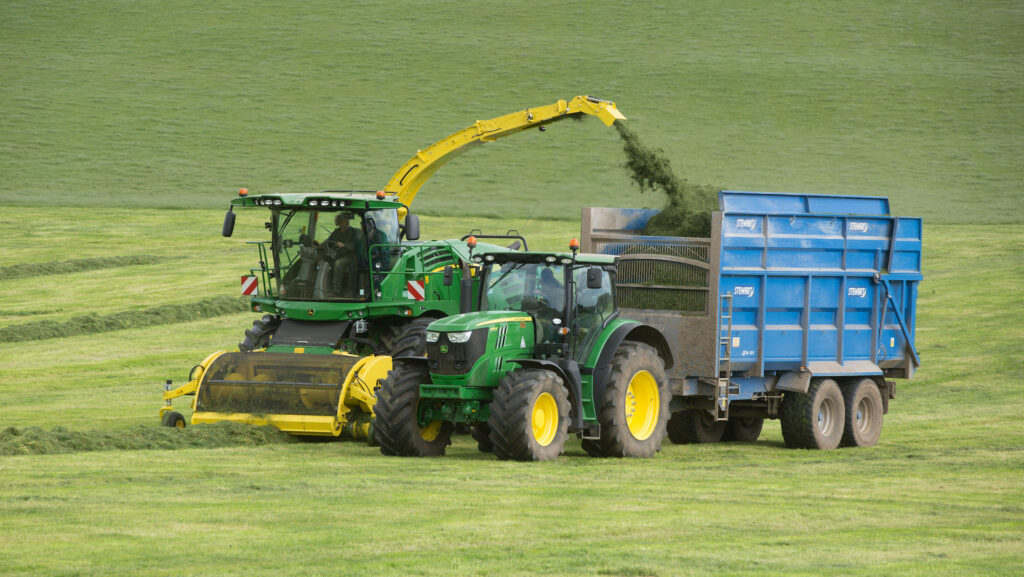Tips on minimising soil compaction on silage ground
 © Tim Scrivener
© Tim Scrivener Operating a controlled traffic system on silage fields this year – for both nutrient applications and grass harvesting – should prevent soil compaction.
Giving up rolling (to push stones back into the ground) before mowing – unless it is with a spike aerator – will also help, says soil and nutrition specialist Mark Tripney, of ISoils.
See also: Three-cut silage: Go for leaves, not bulk, to lower costs
He points out that compaction from extra vehicular traffic, or heavy rollers, leads to poor drainage and anaerobic soils, which can lose a minimum 1.5t/ha dry matter from silage yields.
“You also get a shorter growing season because there is no natural air movement in compacted soils, so they are slow to get going in spring. And, if a field is anaerobic, it changes the nutrient profile available and plant uptakes,” he says.
“Grass plant root development depends on good soil structure too. When it’s poor, shallow roots feed on surface nutrients and are less resilient when conditions dry out.”
Use of headlands for traffic
One unintended consequence from switching to multicut silage, to improve grass quality going into clamps, has been the extra vehicle traffic from taking four to six cuts a year.
“If you stand in a gateway, you can see the fanning of tracks from people driving all over the field,” says Mark. “Instead, they should drive to the headland, then drive around the headland to the gateway. This creates a track that can be subsoiled at a later date.”

© Tim Scrivener
Tactics to prevent surface damage begin with paying more attention to conditions, such as not travelling on fields when it is wet, and/or using low ground pressure tyres, he says.
“Don’t fill trailers to the max if ground is soft: it removes potential extra compaction and reduces the risk of getting stuck. Surface damage in damp conditions compacts and seals the soil, leading to anaerobic conditions and surface run-off.”
After the season has finished, Mark suggests digging holes across silage fields in autumn to check for compaction in the soil profile. “A good spike aerator can shatter anything less than 15cm down; deeper compaction will need a grass subsoiler.”
Impact of suboptimal soil chemistry
However, he stresses that preventing and correcting compaction are only part of the story. Where soil chemistry is out of balance, structural issues remain. Soil analysis will show whether key nutrients – particularly calcium and magnesium – are in proportion.
“Low calcium is highly likely to lead to compaction because it [calcium] helps create flocculation and air spaces, which leads to drainage and allows root penetration. Soils high in magnesium are sticky and lack flexibility.”
The optimum pH for grassland is 6.4 or 6.5, but Mark points out even this does not mean calcium levels are correct, because pH is affected by magnesium, potassium and calcium.
“Sorting out the imbalances is fundamental and will transfer into a better mineral profile in the forage,” he adds.
“At pH 6, 11% of nitrogen is lost from the soil through denitrification, leaching or volatilisation; and 48% of phosphorus is locked up. Make sure enough calcium is going back in through the season: granulated lime is good to go on at any time moisture is coming. Bulk lime is for autumn spreading.”
Cultivations for reseeds
Mark advises preventing compaction in an autumn reseed by using min-till techniques such as direct drilling to create a fine, firm seedbed. Overuse of power harrows followed by flat rolling to get seed into contact with the soil should be avoided. It “squashes the life out of it”, says Mark.
“Seed just needs to be in the top 10-15mm. If you really have to roll, ring roll it – this is lighter. Many people now direct drill their reseeds because ploughing buries the fertile top 100mm of soil.”
